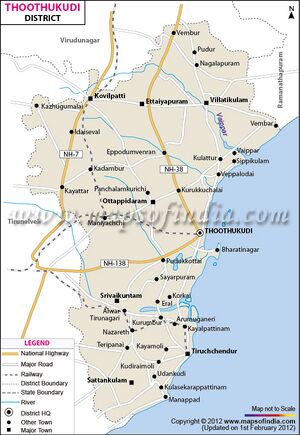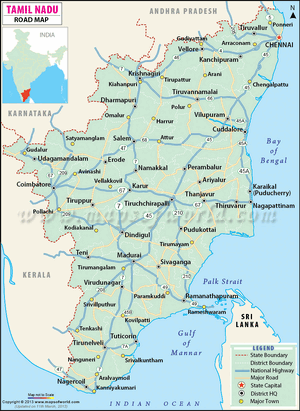Adichanallur
| Author:Laxman Burdak, IFS (R) |


Adichanallur (आदिचानल्लूर) is an archaeological site in Thoothukudi district in Tamil Nadu, India that has been the site of a number of very important archaeological finds.
Variants
Location
Adichanallur is located on the lower valley of the Tamirabarani river in Srivaikuntam taluk in present-day Thoothukudi district in southern Tamil Nadu. Korkai, the ancient seaport mentioned in Sangam literature, is about 25 km from Adichanallur. Korkai is well inland today, with the sea receding several kilometers. [1]
This archeological site is located at a distance of about 24 km from Tirunelveli on the way to Thiruchendur.[2]
History
Korkai, the capital of the Early Pandyan Kingdom, is located about 15 km from Adichanallur. Carbon dating of samples excavated in 2004 from the Adichanallur site has revealed that they belonged to the period between 1000 BC and 600 BC.[3][4] In 2005, around 169 clay urns containing human skeletons were unearthed that date back to at-least 3,800 years.[5] In 2018, research on skeletons remains were dated at Manipur University to 1500 BC (+ or - 700 years).[6][7]
Nagavanshi History
Dr Naval Viyogi[8] writes.... Usually the cobra is carved in relief on a stone slab some four feet in height. But at Adichanallur[9] (a well known large centre of Magaliths) in the Tinnevelly district, there is a large group of Nagakals which shows the peculiarity that they are carved in the round. The snakes are either single-hooded or many-hooded and several of the later have a little human figure seated on the coils and overshaded by the serpents' hood.
Excavations
In 2004, a number of skeletons were found buried in earthenware urns. Some of these urns contained writing in Tamil Brahmi script. While some of the burial urns contained skeletons of Tamil origin, others were found with remains of mostly Australoid, Southeast Asian, East Asian and others. The Australoid were likely contemporary Australian aborigines who were known to have had seafaring qualities[10]
On March 18, 2019, the report of artifact samples sent to Beta Analytic Testing Laboratory, USA for carbon dating was obtained. The results were submitted to the Madurai Bench of the Madras High Court on April 4, 2019. Carbon dating of samples excavated from the Adichanallur site in Thoothukudi district has revealed that they belonged to the period between 905 BC to 696 BC. A Division Bench of Justices N. Kirubakaran and S. S. Sundar observed that this proved Adichanallur was one of the earliest ancient sites in Tamil Nadu. The court had expressed its displeasure that the artifacts, first excavated in 2004-06 under the supervision of the then Superintending Archaeologist T. Satyamurthy, were not sent for carbon dating for over 15 years. “ In spite of many efforts taken by intellectuals, historians, political leaders and archaeologists, nothing was done by the ASI, for reasons best known to them, to send the Adichanallur samples for carbon dating,” the court said. The court had earlier directed the ASI to fence the whole site that is spread across 114 acres and put up a police outpost to prevent any damage. With Sathyabama Badrinath, former Regional Director (South), ASI, currently with the Delhi circle, nominated for preparing the report, the court said that the reports of T. Satyamurthy could also be added in achieving a comprehensive report.[11]
आदिचल्लूर
आदिचल्लूर है एक पुरातात्विक स्थल में थथुकुडी जिला में तमिलनाडु, भारत यह एक बहुत ही महत्वपूर्ण पुरातात्विक खोज का स्थल रहा है। कोरकाई, की राजधानी प्रारंभिक पांडियन साम्राज्य, आदिचनल्लूर से लगभग 15 किमी दूर स्थित है। आदिचनल्लूर साइट से 2004 में खोदे गए नमूनों की कार्बन डेटिंग से पता चला है कि वे 1000 ईसा पूर्व से 600 ईसा पूर्व की अवधि के थे। 2005 में, मानव कंकाल वाले लगभग 169 मिट्टी के कलश का पता लगाया गया था, जो कि कम से कम 3,800 साल पहले की तारीख थी।[3] 2018 में, मणिपुर विश्वविद्यालय में 1500 ईसा पूर्व (+ या - 700 वर्ष) में कंकाल के अवशेषों पर शोध किया गया था।
2004 में, मिट्टी के बरतन में कई कंकाल पाए गए थे कलश। इनमें से कुछ कलशों में लेखन था तमिल ब्राह्मी स्क्रिप्ट। जबकि कुछ दफन कलशों में तमिल मूल के कंकाल शामिल थे, अन्य को ज्यादातर ऑस्ट्रलॉइड, दक्षिण पूर्व एशियाई, पूर्वी एशियाई और अन्य के अवशेष मिले। ऑस्ट्रलॉइड संभवतः समकालीन ऑस्ट्रेलियाई आदिवासी थे, जिनके पास समुद्र में रहने वाले गुण थे।
18 मार्च, 2019 को कार्बन डेटिंग के लिए बीटा एनालिटिक टेस्टिंग लेबोरेटरी, यूएसए को भेजे गए कलाकृतियों के नमूनों की रिपोर्ट प्राप्त हुई। परिणाम 04 अप्रैल, 2019 को मद्रास उच्च न्यायालय की मदुरै बेंच को सौंपे गए। थूथुकुडी जिले में एडिचनल्लूर साइट से उत्खनन किए गए नमूनों की कार्बन डेटिंग से पता चला है कि वे 905 ईसा पूर्व और 697 ईसा पूर्व के बीच की अवधि के थे। जस्टिस एन। किरुबाकरन और एस। एस। सुंदर की डिवीजन बेंच ने माना कि यह साबित हो गया कि तमिलनाडु में आदिकल्लूर सबसे प्राचीन प्राचीन स्थलों में से एक था। अदालत ने अपनी नाराजगी व्यक्त की थी कि 2004-06 में तत्कालीन अधीक्षण पुरातत्वविद टी। सत्यमूर्ति की देखरेख में पहली बार खुदाई की गई कलाकृतियों को 15 वर्षों से कार्बन डेटिंग के लिए नहीं भेजा गया था। अदालत ने कहा, "बुद्धिजीवियों, इतिहासकारों, राजनीतिक नेताओं और पुरातत्वविदों द्वारा किए गए कई प्रयासों के बावजूद, कार्बन डेटिंग के लिए एडिचनल्लूर के नमूने भेजने के लिए एएसआई द्वारा कुछ भी नहीं किया गया था।" अदालत ने पहले एएसआई को निर्देश दिया था कि वह 114 एकड़ में फैली पूरी साइट को बंद कर दे और किसी भी नुकसान को रोकने के लिए पुलिस चौकी लगाए। वर्तमान में दिल्ली सर्कल के साथ एएसआई के पूर्व क्षेत्रीय निदेशक (दक्षिण) श्यामाबामा बद्रीनाथ ने रिपोर्ट तैयार करने के लिए नामांकित किया, अदालत ने कहा कि एक व्यापक रिपोर्ट हासिल करने में टी। सत्यमूर्ति की रिपोर्ट को भी जोड़ा जा सकता है।
ऐतिहासिक उत्खनन: एडिचनल्लूर ने पहली बार वर्ष 1876 में ध्यान आकर्षित किया जब तीन प्रतिष्ठित लोगों की एक टीम ने इसका दौरा किया। टीम में तिरूनेल जिले के तत्कालीन कलेक्टर, जिला अभियंता और जर्मनी के एक नृशास्त्री शामिल थे जिन्हें डॉ। जगोर कहा जाता है। टीम ने एक टीले के एक तरफ खुदाई शुरू की और 19 वीं शताब्दी के उत्तरार्ध के बाज़ारों में बेचे जाने वाले लोगों की तुलना में कई मिट्टी के बर्तनों की खोज की। इसके अलावा पके हुए मिट्टी के बर्तन, बहुत सारे लोहे के हथियार और औजार (मुख्य रूप से चाकू, छोटी तलवार के ब्लेड और हैचेट) और हड्डियों और खोपड़ी की एक बड़ी संख्या में पाया गया।
अलेक्जेंडर री, दक्षिणी सर्किल भारतीय पुरातत्व सर्वेक्षण के एक पूर्व अधीक्षक ने बताया कि ये सभी कलाकृतियाँ डॉ। जगोर द्वारा बर्लिन संग्रहालय फर वर्ल्केन्डे के लिए ले ली गई थीं, जिन्हें वर्तमान में बर्लिन का एथोलॉजिकल संग्रहालय कहा जाता है। अलेक्जेंडर री ने स्वयं 1899 और 1905 के बीच की अवधि के दौरान साइटों की विस्तृत जांच की थी, जब वह डॉ। जगोर के समान बड़ी संख्या में कलाकृतियों को खोजने में सक्षम थे।
सभी कलाकृतियों को जो पाया गया था, उन्हें तुरंत 1915 में "एडिकांल्लूर और पेराम्बेयर से प्रागैतिहासिक प्राचीन कैटलॉग" शीर्षक वाली पुस्तक में सूचीबद्ध किया गया था। यह ध्यान रखना आश्चर्यजनक है कि हालांकि इस सूची में बड़ी मात्रा में कांस्य, लोहा, सोना और मिट्टी की कलाकृतियां शामिल हैं, लेकिन वर्तमान में हुई खुदाई में मुख्य रूप से केवल मिट्टी के सामानों की ही उपज है। रीयाल की सभी कलाकृतियाँ कथित रूप से भारत में मौजूद हैं, हालांकि यह स्पष्ट नहीं है कि उन्हें सही तरीके से संरक्षित किया जा रहा है या नहीं।
External links
References
- ↑ [ https://www.thenewsminute.com/article/adichanallur-brief-history-one-oldest-archaeological-sites-india-134150 Adichanallur: A brief history on one of the oldest archaeological sites in India]
- ↑ https://telibrary.com/en/adichanallur-archaeological-site/
- ↑ Chandar, B. Tilak (5 April 2019). "Adichanallur site belongs to a period between 905 and 696 BC". The Hindu. Retrieved 6 April 2019 – via www.thehindu.com.
- ↑ Chandar, B. Tilak (26 February 2019). "Samples sent for carbon dating: ASI". The Hindu. ISSN 0971-751X.
- ↑ "Skeletons dating back 3,800 years throw light on evolution - Times of India".
- ↑ Kalyanaraman, M. (12 January 2018). "The ghosts of Adichanallur: Artefacts that suggest an ancient Tamil civilisation of great sophistication". The Hindu. ISSN 0971-751X.
- ↑ Subramanian, T. S. (17 February 2005). "'Rudimentary Tamil-Brahmi script' unearthed at Adichanallur". The Hindu. ISSN 0971-751X.
- ↑ Nagas, The Ancient Rulers of India, Their Origins and History, 2002, p. 31
- ↑ Vogel JPH P-271
- ↑ Kalyanaraman, M. (12 January 2018). "The ghosts of Adichanallur: Artefacts that suggest an ancient Tamil civilisation of great sophistication". The Hindu.
- ↑ Chandar, B. Tilak (5 April 2019). "Adichanallur site belongs to a period between 905 and 696 BC". The Hindu. Retrieved 6 April 2019 – via www.thehindu.com.

